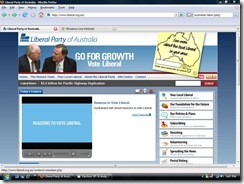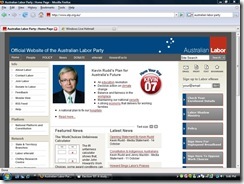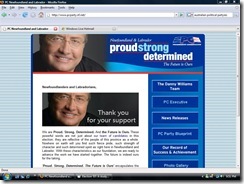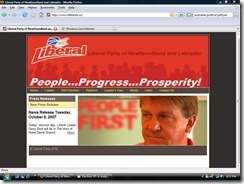If you want to see what savvy political use of the Internet looks like, then take a look at the Australian political parties.
 The incumbent Liberal Party site has all the right bits including multi-media presentation, ways to get involved (donate, volunteer etc), and information on the platform. The site includes RSS which allows people to get regular updates without having to visit the site: in other words it pushes information at the voter in a way that can be viewed as either a supplement to other means of communication or as a way of bypassing news media filters.
The incumbent Liberal Party site has all the right bits including multi-media presentation, ways to get involved (donate, volunteer etc), and information on the platform. The site includes RSS which allows people to get regular updates without having to visit the site: in other words it pushes information at the voter in a way that can be viewed as either a supplement to other means of communication or as a way of bypassing news media filters.
 The same can be said of the Labor Party site.
The same can be said of the Labor Party site.
Compare that to the main websites in the recent provincial election Newfoundland and Labrador.
 While the Progressive Conservative site was the best of the three, it was very much the best of the old school. This is not a site designed to encourage citizen participation. It is merely a one-way message sending site and the only message really being sent is the face of the commodity being marketed.
While the Progressive Conservative site was the best of the three, it was very much the best of the old school. This is not a site designed to encourage citizen participation. It is merely a one-way message sending site and the only message really being sent is the face of the commodity being marketed.
Take a stroll through the site and look at the contradictory messaging. There's much talk of "team" but how many images show "The Leader" without a team anywhere to be seen?
 The Liberal site was built on the same basic concept of message send without any concern for feedback, interaction or even stimulation. There was nothing on either the Tory or Grit sites to do that: this is elitist, top-down politics.
The Liberal site was built on the same basic concept of message send without any concern for feedback, interaction or even stimulation. There was nothing on either the Tory or Grit sites to do that: this is elitist, top-down politics.
The site was marred by dead links (let alone irrelevant ones) and a platform document that was cumbersome to access.
Take a look at the picture on the front. No people. Just a glum-faced Gerry Reid in what unfortunately became the defining image of the Liberal Party.
 The provincial New Democrats fell very much into the same old school approach and their website is just the non-election site with some new stuff on it.
The provincial New Democrats fell very much into the same old school approach and their website is just the non-election site with some new stuff on it.
Sure the provincial NDP is a small outfit and they are still suffering the effects of the long stagnant leadership of Jack Harris, but as with the Liberals, they really don't have much of an excuse for such an unimpressive site. This Internet stuff is actually easy and relatively cheap to do. For parties with little cash to throw around, Internet campaigns can be a way of reaching audiences inexpensively but very effectively.
While there's no way of knowing for sure - unless the parties released their traffic details - consider that the Liberals and the New Democrats likely had less attention paid to their online media than I.P. Freely did. A few clicks and you can find the youtube.com homepage for the I.P. Freely videos. Take a look at the total views for each one. Even the stuff posted during the recent election had hits in the hundreds and that's on a site that wasn't being promoted as heavily as either the Liberal or New Democrat ones. For all the technical and other flaws the I.P materials show, people were interested enough to look at them.
The Internet is a communications tool waiting to be used. The examples are there. Local political parties just have to decide to use it. Rather than moan about voter 'apathy", political parties just need to find new ways to reach voters.